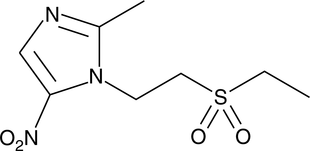Chemicals
Showing 38101–38250 of 41137 results
-
Ticarcillin is a semisynthetic β-lactam antibiotic.{43551,43552} It is active against P. aeruginosa, E. coli, P. mirabilis, P. rettgeri, and K. aerogenes (MICs = 4-125 μg/ml).{43552} Topical administration of ticarcillin (2.5 mg per eye) reduces P. aeruginosa colony count in rabbit eye.{43551} Formulations containing ticarcillin have been used in the treatment of a variety of bacterial infections.
Brand:CaymanSKU:26065 - 10 gAvailable on backorder
Ticarcillin is a semisynthetic β-lactam antibiotic.{43551,43552} It is active against P. aeruginosa, E. coli, P. mirabilis, P. rettgeri, and K. aerogenes (MICs = 4-125 μg/ml).{43552} Topical administration of ticarcillin (2.5 mg per eye) reduces P. aeruginosa colony count in rabbit eye.{43551} Formulations containing ticarcillin have been used in the treatment of a variety of bacterial infections.
Brand:CaymanSKU:26065 - 25 gAvailable on backorder
Ticarcillin is a semisynthetic β-lactam antibiotic.{43551,43552} It is active against P. aeruginosa, E. coli, P. mirabilis, P. rettgeri, and K. aerogenes (MICs = 4-125 μg/ml).{43552} Topical administration of ticarcillin (2.5 mg per eye) reduces P. aeruginosa colony count in rabbit eye.{43551} Formulations containing ticarcillin have been used in the treatment of a variety of bacterial infections.
Brand:CaymanSKU:26065 - 5 gAvailable on backorder
Ticlopidine is a thienopyridine P2Y12 receptor antagonist.{37611} It inhibits aggregation of human platelets induced by collagen, arachidonic acid (Item No. 90010), and ADP (Item No. 16778; IC50s = 75, 600, and 1,300 μM, respectively).{37612} It also inhibits ADP-induced aggregation of rat platelets and decreases thrombus weight in vivo in a rat model of arterio-venous shunt thrombosis when administered at a dose of 100 mg/kg.{23697} Ticlopidine (300 mg/kg) inhibits healing of acetic acid-induced gastric ulcers in rats.{37613} Formulations containing ticlopidine have been used in the prevention of thrombotic stroke.
Brand:CaymanSKU:20770 -Available on backorder
Ticlopidine is a thienopyridine P2Y12 receptor antagonist.{37611} It inhibits aggregation of human platelets induced by collagen, arachidonic acid (Item No. 90010), and ADP (Item No. 16778; IC50s = 75, 600, and 1,300 μM, respectively).{37612} It also inhibits ADP-induced aggregation of rat platelets and decreases thrombus weight in vivo in a rat model of arterio-venous shunt thrombosis when administered at a dose of 100 mg/kg.{23697} Ticlopidine (300 mg/kg) inhibits healing of acetic acid-induced gastric ulcers in rats.{37613} Formulations containing ticlopidine have been used in the prevention of thrombotic stroke.
Brand:CaymanSKU:20770 -Available on backorder
Ticlopidine is a thienopyridine P2Y12 receptor antagonist.{37611} It inhibits aggregation of human platelets induced by collagen, arachidonic acid (Item No. 90010), and ADP (Item No. 16778; IC50s = 75, 600, and 1,300 μM, respectively).{37612} It also inhibits ADP-induced aggregation of rat platelets and decreases thrombus weight in vivo in a rat model of arterio-venous shunt thrombosis when administered at a dose of 100 mg/kg.{23697} Ticlopidine (300 mg/kg) inhibits healing of acetic acid-induced gastric ulcers in rats.{37613} Formulations containing ticlopidine have been used in the prevention of thrombotic stroke.
Brand:CaymanSKU:20770 -Available on backorder
Ticlopidine is a thienopyridine P2Y12 receptor antagonist.{37611} It inhibits aggregation of human platelets induced by collagen, arachidonic acid (Item No. 90010), and ADP (Item No. 16778; IC50s = 75, 600, and 1,300 μM, respectively).{37612} It also inhibits ADP-induced aggregation of rat platelets and decreases thrombus weight in vivo in a rat model of arterio-venous shunt thrombosis when administered at a dose of 100 mg/kg.{23697} Ticlopidine (300 mg/kg) inhibits healing of acetic acid-induced gastric ulcers in rats.{37613} Formulations containing ticlopidine have been used in the prevention of thrombotic stroke.
Brand:CaymanSKU:20770 -Available on backorder
Tideglusib is a thiadiazolidinone that prevents inflammation and neurodegeneration when injected into rat hippocampus concurrently with kainic acid, a compound that causes excitotoxicity.{27696} Tideglusib-induced neuroprotection, in this model, is attenuated by the PPARγ antagonist GW9662 (Item No. 70785).{27696} Interestingly, tideglusib also irreversibly inhibits glycogen synthase kinase-3β (GSK3β) with an IC50 value of 5 nM when used with a one hour preincubation, increasing to 0.1-1 µM without preincubation.{27697,27698} Several GSK3 inhibitors, including tideglusib, promote hippocampal neurogenesis both in vitro and in vivo, suggesting suitability in Alzheimer’s therapy.{27698,27699}
Brand:CaymanSKU:-Out of stock
Tideglusib is a thiadiazolidinone that prevents inflammation and neurodegeneration when injected into rat hippocampus concurrently with kainic acid, a compound that causes excitotoxicity.{27696} Tideglusib-induced neuroprotection, in this model, is attenuated by the PPARγ antagonist GW9662 (Item No. 70785).{27696} Interestingly, tideglusib also irreversibly inhibits glycogen synthase kinase-3β (GSK3β) with an IC50 value of 5 nM when used with a one hour preincubation, increasing to 0.1-1 µM without preincubation.{27697,27698} Several GSK3 inhibitors, including tideglusib, promote hippocampal neurogenesis both in vitro and in vivo, suggesting suitability in Alzheimer’s therapy.{27698,27699}
Brand:CaymanSKU:-Out of stock
Tideglusib is a thiadiazolidinone that prevents inflammation and neurodegeneration when injected into rat hippocampus concurrently with kainic acid, a compound that causes excitotoxicity.{27696} Tideglusib-induced neuroprotection, in this model, is attenuated by the PPARγ antagonist GW9662 (Item No. 70785).{27696} Interestingly, tideglusib also irreversibly inhibits glycogen synthase kinase-3β (GSK3β) with an IC50 value of 5 nM when used with a one hour preincubation, increasing to 0.1-1 µM without preincubation.{27697,27698} Several GSK3 inhibitors, including tideglusib, promote hippocampal neurogenesis both in vitro and in vivo, suggesting suitability in Alzheimer’s therapy.{27698,27699}
Brand:CaymanSKU:-Out of stock
Tie2 Inhibitor 7 blocks Tie2 kinase activity with a Ki value of 1.3 µM.{31456}. It has been shown to inhibit angiopoietin 1-induced Tie2 autophosphorylation and downstream signaling with an IC50 value of 0.3 µM.{31456} This compound can prevent endothelial cell tube formation and aberrant vessel growth in a rat model of Matrigel-induced choroidal neovascularization.{31456}
Brand:CaymanSKU:-Available on backorder
Tie2 Inhibitor 7 blocks Tie2 kinase activity with a Ki value of 1.3 µM.{31456}. It has been shown to inhibit angiopoietin 1-induced Tie2 autophosphorylation and downstream signaling with an IC50 value of 0.3 µM.{31456} This compound can prevent endothelial cell tube formation and aberrant vessel growth in a rat model of Matrigel-induced choroidal neovascularization.{31456}
Brand:CaymanSKU:-Available on backorder
Tie2 Inhibitor 7 blocks Tie2 kinase activity with a Ki value of 1.3 µM.{31456}. It has been shown to inhibit angiopoietin 1-induced Tie2 autophosphorylation and downstream signaling with an IC50 value of 0.3 µM.{31456} This compound can prevent endothelial cell tube formation and aberrant vessel growth in a rat model of Matrigel-induced choroidal neovascularization.{31456}
Brand:CaymanSKU:-Available on backorder
Tunica interna endothelial cell kinase 2 (Tie2, also known as angiopoietin-1 receptor or tek) is an endothelium-specific receptor tyrosine kinase important for the development of embryonic vasculature and for angiogenesis and vascular maintenance in adult tissues.{10075} Tie2 kinase inhibitor reversibly and selectively blocks Tie2 kinase activity with an IC50 value of 250 nM.{29691} It is 200-fold more potent for inhibition of Tie2 compared to p38.{29691} Tie2 kinase inhibitor has been shown to reduce angiogenesis in a Matrigel neovascularization assay and to delay tumor growth in MOPC-315 plasmacytoma and SVR angiosarcoma xenograft models.{29691,29690}
Brand:CaymanSKU:-Available on backorder
Tunica interna endothelial cell kinase 2 (Tie2, also known as angiopoietin-1 receptor or tek) is an endothelium-specific receptor tyrosine kinase important for the development of embryonic vasculature and for angiogenesis and vascular maintenance in adult tissues.{10075} Tie2 kinase inhibitor reversibly and selectively blocks Tie2 kinase activity with an IC50 value of 250 nM.{29691} It is 200-fold more potent for inhibition of Tie2 compared to p38.{29691} Tie2 kinase inhibitor has been shown to reduce angiogenesis in a Matrigel neovascularization assay and to delay tumor growth in MOPC-315 plasmacytoma and SVR angiosarcoma xenograft models.{29691,29690}
Brand:CaymanSKU:-Available on backorder
Tunica interna endothelial cell kinase 2 (Tie2, also known as angiopoietin-1 receptor or tek) is an endothelium-specific receptor tyrosine kinase important for the development of embryonic vasculature and for angiogenesis and vascular maintenance in adult tissues.{10075} Tie2 kinase inhibitor reversibly and selectively blocks Tie2 kinase activity with an IC50 value of 250 nM.{29691} It is 200-fold more potent for inhibition of Tie2 compared to p38.{29691} Tie2 kinase inhibitor has been shown to reduce angiogenesis in a Matrigel neovascularization assay and to delay tumor growth in MOPC-315 plasmacytoma and SVR angiosarcoma xenograft models.{29691,29690}
Brand:CaymanSKU:-Available on backorder
Tunica interna endothelial cell kinase 2 (Tie2, also known as angiopoietin-1 receptor or tek) is an endothelium-specific receptor tyrosine kinase important for the development of embryonic vasculature and for angiogenesis and vascular maintenance in adult tissues.{10075} Tie2 kinase inhibitor reversibly and selectively blocks Tie2 kinase activity with an IC50 value of 250 nM.{29691} It is 200-fold more potent for inhibition of Tie2 compared to p38.{29691} Tie2 kinase inhibitor has been shown to reduce angiogenesis in a Matrigel neovascularization assay and to delay tumor growth in MOPC-315 plasmacytoma and SVR angiosarcoma xenograft models.{29691,29690}
Brand:CaymanSKU:-Available on backorder
Cytochrome P450 enzymes function to metabolize both endogenous and exogenous compounds. Both the 3A and 2C isoforms are present in human liver of which CYP2C9 seems most highly expressed.{14151} Tienilic acid is a specific suicide substrate for CYP2C9 and CYP2C10 whereby its oxidation inactivates the enzyme.{14150,14152} The time required to inactivate one half of the CYP2C10 enzyme at the maximal rate (t½max) is 3.4 minutes, with a dissociation constant (KI) value of 4.3 µM.{14152}
Brand:CaymanSKU:10008517 - 10 mgAvailable on backorder
Cytochrome P450 enzymes function to metabolize both endogenous and exogenous compounds. Both the 3A and 2C isoforms are present in human liver of which CYP2C9 seems most highly expressed.{14151} Tienilic acid is a specific suicide substrate for CYP2C9 and CYP2C10 whereby its oxidation inactivates the enzyme.{14150,14152} The time required to inactivate one half of the CYP2C10 enzyme at the maximal rate (t½max) is 3.4 minutes, with a dissociation constant (KI) value of 4.3 µM.{14152}
Brand:CaymanSKU:10008517 - 25 mgAvailable on backorder
Cytochrome P450 enzymes function to metabolize both endogenous and exogenous compounds. Both the 3A and 2C isoforms are present in human liver of which CYP2C9 seems most highly expressed.{14151} Tienilic acid is a specific suicide substrate for CYP2C9 and CYP2C10 whereby its oxidation inactivates the enzyme.{14150,14152} The time required to inactivate one half of the CYP2C10 enzyme at the maximal rate (t½max) is 3.4 minutes, with a dissociation constant (KI) value of 4.3 µM.{14152}
Brand:CaymanSKU:10008517 - 5 mgAvailable on backorder
Cytochrome P450 enzymes function to metabolize both endogenous and exogenous compounds. Both the 3A and 2C isoforms are present in human liver of which CYP2C9 seems most highly expressed.{14151} Tienilic acid is a specific suicide substrate for CYP2C9 and CYP2C10 whereby its oxidation inactivates the enzyme.{14150,14152} The time required to inactivate one half of the CYP2C10 enzyme at the maximal rate (t½max) is 3.4 minutes, with a dissociation constant (KI) value of 4.3 µM.{14152}
Brand:CaymanSKU:10008517 - 50 mgAvailable on backorder
Tigecycline is a broad-spectrum glycylcycline antibiotic that binds to the bacterial 30S ribosome, blocking the entry of transfer RNA, which halts protein synthesis and inhibits bacterial growth.{22659} It is active against a panel of 1,924 European clinical bacterial isolates including S. aureus, S. epidermidis, S. pneumoniae, E. faecalis, E. faecium, E. coli, K. pneumoniae, P. aeruginosa, and P. mirabilis strains (MICs = In vivo, tigecycline (6.25 mg/kg twice daily for 5 days) decreases levels of C. difficile cytotoxin activity and spore formation in cecum and colon in a mouse model of C. difficile infection.{42396} Formulations containing tigecycline have been used in the treatment of a variety of bacterial infections.
Brand:CaymanSKU:-Tigecycline is a broad-spectrum glycylcycline antibiotic that binds to the bacterial 30S ribosome, blocking the entry of transfer RNA, which halts protein synthesis and inhibits bacterial growth.{22659} It is active against a panel of 1,924 European clinical bacterial isolates including S. aureus, S. epidermidis, S. pneumoniae, E. faecalis, E. faecium, E. coli, K. pneumoniae, P. aeruginosa, and P. mirabilis strains (MICs = In vivo, tigecycline (6.25 mg/kg twice daily for 5 days) decreases levels of C. difficile cytotoxin activity and spore formation in cecum and colon in a mouse model of C. difficile infection.{42396} Formulations containing tigecycline have been used in the treatment of a variety of bacterial infections.
Brand:CaymanSKU:-Tigecycline is a broad-spectrum glycylcycline antibiotic that binds to the bacterial 30S ribosome, blocking the entry of transfer RNA, which halts protein synthesis and inhibits bacterial growth.{22659} It is active against a panel of 1,924 European clinical bacterial isolates including S. aureus, S. epidermidis, S. pneumoniae, E. faecalis, E. faecium, E. coli, K. pneumoniae, P. aeruginosa, and P. mirabilis strains (MICs = In vivo, tigecycline (6.25 mg/kg twice daily for 5 days) decreases levels of C. difficile cytotoxin activity and spore formation in cecum and colon in a mouse model of C. difficile infection.{42396} Formulations containing tigecycline have been used in the treatment of a variety of bacterial infections.
Brand:CaymanSKU:-Tigogenin is a steroidal sapogenin that has been found in A. sisalana and has diverse biological activities.{38813,46840,46841,46842} It increases the proliferation rate of, as well as mRNA levels of genes encoding the osteoblastic differentiation markers Cbfa1, collagen type I, and osteocalcin in, mouse bone marrow stromal cells (BMSCs) in a concentration-dependent manner.{46840} It also increases matrix calcium deposition in BMSCs when used at concentrations of 30 and 90 μM. Tigogenin is active against the fungus A. fumigatus (MIC50 = 16 μg/ml).{46841} It inhibits carrageenan-induced paw edema in rats when administered at a dose of 4.2 μg/kg.{46842}
Brand:CaymanSKU:30137 - 10 mgAvailable on backorder
Tigogenin is a steroidal sapogenin that has been found in A. sisalana and has diverse biological activities.{38813,46840,46841,46842} It increases the proliferation rate of, as well as mRNA levels of genes encoding the osteoblastic differentiation markers Cbfa1, collagen type I, and osteocalcin in, mouse bone marrow stromal cells (BMSCs) in a concentration-dependent manner.{46840} It also increases matrix calcium deposition in BMSCs when used at concentrations of 30 and 90 μM. Tigogenin is active against the fungus A. fumigatus (MIC50 = 16 μg/ml).{46841} It inhibits carrageenan-induced paw edema in rats when administered at a dose of 4.2 μg/kg.{46842}
Brand:CaymanSKU:30137 - 100 mgAvailable on backorder
Tigogenin is a steroidal sapogenin that has been found in A. sisalana and has diverse biological activities.{38813,46840,46841,46842} It increases the proliferation rate of, as well as mRNA levels of genes encoding the osteoblastic differentiation markers Cbfa1, collagen type I, and osteocalcin in, mouse bone marrow stromal cells (BMSCs) in a concentration-dependent manner.{46840} It also increases matrix calcium deposition in BMSCs when used at concentrations of 30 and 90 μM. Tigogenin is active against the fungus A. fumigatus (MIC50 = 16 μg/ml).{46841} It inhibits carrageenan-induced paw edema in rats when administered at a dose of 4.2 μg/kg.{46842}
Brand:CaymanSKU:30137 - 250 mgAvailable on backorder
Tigogenin is a steroidal sapogenin that has been found in A. sisalana and has diverse biological activities.{38813,46840,46841,46842} It increases the proliferation rate of, as well as mRNA levels of genes encoding the osteoblastic differentiation markers Cbfa1, collagen type I, and osteocalcin in, mouse bone marrow stromal cells (BMSCs) in a concentration-dependent manner.{46840} It also increases matrix calcium deposition in BMSCs when used at concentrations of 30 and 90 μM. Tigogenin is active against the fungus A. fumigatus (MIC50 = 16 μg/ml).{46841} It inhibits carrageenan-induced paw edema in rats when administered at a dose of 4.2 μg/kg.{46842}
Brand:CaymanSKU:30137 - 50 mgAvailable on backorder
Tildipirosin is a 16-membered macrolide used as an antibiotic in veterinary medicine. Like other macrolides, it inhibits protein synthesis in bacteria and blocks the production of biofilms.{27769,23113} Tildipirosin is particularly effective against Gram-negative pathogens (MIC = 0.25-1 µg/ml against P. multocida and M. haemolytica).{27769,27770} It is commonly used against respiratory infections in swine and cattle.{27769,27770}
Brand:CaymanSKU:-Out of stock
Tildipirosin is a 16-membered macrolide used as an antibiotic in veterinary medicine. Like other macrolides, it inhibits protein synthesis in bacteria and blocks the production of biofilms.{27769,23113} Tildipirosin is particularly effective against Gram-negative pathogens (MIC = 0.25-1 µg/ml against P. multocida and M. haemolytica).{27769,27770} It is commonly used against respiratory infections in swine and cattle.{27769,27770}
Brand:CaymanSKU:-Out of stock
Tiletamine (hydrochloride) (Item No. 19794) is an analytical reference standard that is structurally classified as an arylcyclohexylamine. It is a non-competitive NMDA receptor antagonist used in veterinary medicine for its anesthetic and sedative properties, which are comparable to ketamine (Item No. 11630).{31787,31788} Abuse of this compound has been documented.{31788} It is intended for forensic and research purposes only.
Brand:CaymanSKU:19794 -Available on backorder
Tiletamine (hydrochloride) (Item No. 19794) is an analytical reference standard that is structurally classified as an arylcyclohexylamine. It is a non-competitive NMDA receptor antagonist used in veterinary medicine for its anesthetic and sedative properties, which are comparable to ketamine (Item No. 11630).{31787,31788} Abuse of this compound has been documented.{31788} It is intended for forensic and research purposes only.
Brand:CaymanSKU:19794 -Available on backorder
Tilfrinib is an inhibitor of breast tumor kinase/protein tyrosine kinase 6 (BRK/PTK6; IC50 = 3.15 nM).{42337,42338} It is selective for BRK/PTK6 over HER2 (IC50 = 1,300 nM).{42338} Tilfrinib inhibits the growth of MCF-7, HS-578/T, and BT-549 breast cancer cells in vitro (GI50s = 0.99, 1.02, and 1.58 μM, respectively).{42337}
Brand:CaymanSKU:25647 - 1 mgAvailable on backorder
Tilfrinib is an inhibitor of breast tumor kinase/protein tyrosine kinase 6 (BRK/PTK6; IC50 = 3.15 nM).{42337,42338} It is selective for BRK/PTK6 over HER2 (IC50 = 1,300 nM).{42338} Tilfrinib inhibits the growth of MCF-7, HS-578/T, and BT-549 breast cancer cells in vitro (GI50s = 0.99, 1.02, and 1.58 μM, respectively).{42337}
Brand:CaymanSKU:25647 - 10 mgAvailable on backorder
Tilfrinib is an inhibitor of breast tumor kinase/protein tyrosine kinase 6 (BRK/PTK6; IC50 = 3.15 nM).{42337,42338} It is selective for BRK/PTK6 over HER2 (IC50 = 1,300 nM).{42338} Tilfrinib inhibits the growth of MCF-7, HS-578/T, and BT-549 breast cancer cells in vitro (GI50s = 0.99, 1.02, and 1.58 μM, respectively).{42337}
Brand:CaymanSKU:25647 - 25 mgAvailable on backorder
Tilfrinib is an inhibitor of breast tumor kinase/protein tyrosine kinase 6 (BRK/PTK6; IC50 = 3.15 nM).{42337,42338} It is selective for BRK/PTK6 over HER2 (IC50 = 1,300 nM).{42338} Tilfrinib inhibits the growth of MCF-7, HS-578/T, and BT-549 breast cancer cells in vitro (GI50s = 0.99, 1.02, and 1.58 μM, respectively).{42337}
Brand:CaymanSKU:25647 - 5 mgAvailable on backorder
Tilmicosin is a macrolide antibiotic that inhibits protein synthesis in bacteria (IC50 = 0.36 µM).{27769} It prevents the growth of M. haemolytica, P. multocida, and E. coli with MIC values of 2-4 µM and is commonly used against respiratory infections in swine and cattle.{27769}
Brand:CaymanSKU:-Available on backorder
Tilmicosin is a macrolide antibiotic that inhibits protein synthesis in bacteria (IC50 = 0.36 µM).{27769} It prevents the growth of M. haemolytica, P. multocida, and E. coli with MIC values of 2-4 µM and is commonly used against respiratory infections in swine and cattle.{27769}
Brand:CaymanSKU:-Available on backorder
Tilmicosin is a macrolide antibiotic that inhibits protein synthesis in bacteria (IC50 = 0.36 µM).{27769} It prevents the growth of M. haemolytica, P. multocida, and E. coli with MIC values of 2-4 µM and is commonly used against respiratory infections in swine and cattle.{27769}
Brand:CaymanSKU:-Available on backorder
Tilmicosin is a macrolide antibiotic that inhibits protein synthesis in bacteria (IC50 = 0.36 µM).{27769} It prevents the growth of M. haemolytica, P. multocida, and E. coli with MIC values of 2-4 µM and is commonly used against respiratory infections in swine and cattle.{27769}
Brand:CaymanSKU:-Available on backorder
Tilorone is an orally active, antiviral compound that induces interferon production and is reported to have antitumor, anti-inflammatory, and neuroprotective actions.{28996,28997,28998} With chronic administration, tilorone induces lysosomal glycosaminoglycan storage, rendering glycosaminoglycans resistant to enzymatic degradation.{28999}
Brand:CaymanSKU:-Available on backorder
Tilorone is an orally active, antiviral compound that induces interferon production and is reported to have antitumor, anti-inflammatory, and neuroprotective actions.{28996,28997,28998} With chronic administration, tilorone induces lysosomal glycosaminoglycan storage, rendering glycosaminoglycans resistant to enzymatic degradation.{28999}
Brand:CaymanSKU:-Available on backorder
Tilorone is an orally active, antiviral compound that induces interferon production and is reported to have antitumor, anti-inflammatory, and neuroprotective actions.{28996,28997,28998} With chronic administration, tilorone induces lysosomal glycosaminoglycan storage, rendering glycosaminoglycans resistant to enzymatic degradation.{28999}
Brand:CaymanSKU:-Available on backorder
Tilorone is an orally active, antiviral compound that induces interferon production and is reported to have antitumor, anti-inflammatory, and neuroprotective actions.{28996,28997,28998} With chronic administration, tilorone induces lysosomal glycosaminoglycan storage, rendering glycosaminoglycans resistant to enzymatic degradation.{28999}
Brand:CaymanSKU:-Available on backorder
Timolol is a non-selective β-adrenergic receptor antagonist with log Kd values of -8.27, -9.86, and -6.8 for binding to human β1-, β2-, and β3-adrenoceptors, respectively.{25151} It has been reported that only the (S) enantiomer contributes to the β-blocking effects of racemic timolol, but the weakly active (R) isomer maintains a beneficial effect on intraocular pressure without the undesirable side-effect of bronchial constriction caused by non-selective action of (S)-timolol on β1 and β2 receptors.{13497,25396} Timolol has been use alone and in fixed combinations with either prostaglandin analogs or carbonic anhydrase inhibitors to reduce intraocular pressure in research models of ocular hypertension and glaucoma.{23436,16983}
Brand:CaymanSKU:-Timolol is a non-selective β-adrenergic receptor antagonist with log Kd values of -8.27, -9.86, and -6.8 for binding to human β1-, β2-, and β3-adrenoceptors, respectively.{25151} It has been reported that only the (S) enantiomer contributes to the β-blocking effects of racemic timolol, but the weakly active (R) isomer maintains a beneficial effect on intraocular pressure without the undesirable side-effect of bronchial constriction caused by non-selective action of (S)-timolol on β1 and β2 receptors.{13497,25396} Timolol has been use alone and in fixed combinations with either prostaglandin analogs or carbonic anhydrase inhibitors to reduce intraocular pressure in research models of ocular hypertension and glaucoma.{23436,16983}
Brand:CaymanSKU:-Timolol is a non-selective β-adrenergic receptor antagonist with log Kd values of -8.27, -9.86, and -6.8 for binding to human β1-, β2-, and β3-adrenoceptors, respectively.{25151} It has been reported that only the (S) enantiomer contributes to the β-blocking effects of racemic timolol, but the weakly active (R) isomer maintains a beneficial effect on intraocular pressure without the undesirable side-effect of bronchial constriction caused by non-selective action of (S)-timolol on β1 and β2 receptors.{13497,25396} Timolol has been use alone and in fixed combinations with either prostaglandin analogs or carbonic anhydrase inhibitors to reduce intraocular pressure in research models of ocular hypertension and glaucoma.{23436,16983}
Brand:CaymanSKU:-Timolol is a non-selective β-adrenergic receptor antagonist with log Kd values of -8.27, -9.86, and -6.8 for binding to human β1-, β2-, and β3-adrenoceptors, respectively.{25151} It has been reported that only the (S) enantiomer contributes to the β-blocking effects of racemic timolol, but the weakly active (R) isomer maintains a beneficial effect on intraocular pressure without the undesirable side-effect of bronchial constriction caused by non-selective action of (S)-timolol on β1 and β2 receptors.{13497,25396} Timolol has been use alone and in fixed combinations with either prostaglandin analogs or carbonic anhydrase inhibitors to reduce intraocular pressure in research models of ocular hypertension and glaucoma.{23436,16983}
Brand:CaymanSKU:-Timosaponin AIII (TAIII) is a steroidal saponin isolated from A. asphodeloides that has anticancer, anti-inflammatory, and antithrombotic activities and also improves learning and memory deficits in mice.{36060,36061,36062,36063,36064} It inhibits invasive activity and COX-2 gene expression induced by hepatocyte growth factor (HGF) in MDA-MB-231 breast cancer cells and B16-F10 melanoma cells in a concentration-dependent manner.{36063,36064} TAIII (25 mg/kg) significantly reduces the number of metastatic nodules in B16-F10 melanoma cell-treated mice.{36063} Oral administration of TAIII reduces 2,3,4-trinitrobenzene sulfonic acid-induced colon shortening, myeloperoxidase activity, NF-kB activation, and IL-1β, TNF-α, and IL-6 levels in mice.{36061} TAIII reduces mortality and venous thrombus weight in mice with acute thromboembolism.{36062} It inhibits acetylcholinesterase in vitro (AChE; IC50 = 35.4 μM) and improves scopolamine-induced learning and memory deficits in mice, as measured using the passive avoidance test and Morris water maze.{36060}
Brand:CaymanSKU:22236 -Out of stock
Timosaponin AIII (TAIII) is a steroidal saponin isolated from A. asphodeloides that has anticancer, anti-inflammatory, and antithrombotic activities and also improves learning and memory deficits in mice.{36060,36061,36062,36063,36064} It inhibits invasive activity and COX-2 gene expression induced by hepatocyte growth factor (HGF) in MDA-MB-231 breast cancer cells and B16-F10 melanoma cells in a concentration-dependent manner.{36063,36064} TAIII (25 mg/kg) significantly reduces the number of metastatic nodules in B16-F10 melanoma cell-treated mice.{36063} Oral administration of TAIII reduces 2,3,4-trinitrobenzene sulfonic acid-induced colon shortening, myeloperoxidase activity, NF-kB activation, and IL-1β, TNF-α, and IL-6 levels in mice.{36061} TAIII reduces mortality and venous thrombus weight in mice with acute thromboembolism.{36062} It inhibits acetylcholinesterase in vitro (AChE; IC50 = 35.4 μM) and improves scopolamine-induced learning and memory deficits in mice, as measured using the passive avoidance test and Morris water maze.{36060}
Brand:CaymanSKU:22236 -Out of stock
Timosaponin AIII (TAIII) is a steroidal saponin isolated from A. asphodeloides that has anticancer, anti-inflammatory, and antithrombotic activities and also improves learning and memory deficits in mice.{36060,36061,36062,36063,36064} It inhibits invasive activity and COX-2 gene expression induced by hepatocyte growth factor (HGF) in MDA-MB-231 breast cancer cells and B16-F10 melanoma cells in a concentration-dependent manner.{36063,36064} TAIII (25 mg/kg) significantly reduces the number of metastatic nodules in B16-F10 melanoma cell-treated mice.{36063} Oral administration of TAIII reduces 2,3,4-trinitrobenzene sulfonic acid-induced colon shortening, myeloperoxidase activity, NF-kB activation, and IL-1β, TNF-α, and IL-6 levels in mice.{36061} TAIII reduces mortality and venous thrombus weight in mice with acute thromboembolism.{36062} It inhibits acetylcholinesterase in vitro (AChE; IC50 = 35.4 μM) and improves scopolamine-induced learning and memory deficits in mice, as measured using the passive avoidance test and Morris water maze.{36060}
Brand:CaymanSKU:22236 -Out of stock
Timosaponin AIII (TAIII) is a steroidal saponin isolated from A. asphodeloides that has anticancer, anti-inflammatory, and antithrombotic activities and also improves learning and memory deficits in mice.{36060,36061,36062,36063,36064} It inhibits invasive activity and COX-2 gene expression induced by hepatocyte growth factor (HGF) in MDA-MB-231 breast cancer cells and B16-F10 melanoma cells in a concentration-dependent manner.{36063,36064} TAIII (25 mg/kg) significantly reduces the number of metastatic nodules in B16-F10 melanoma cell-treated mice.{36063} Oral administration of TAIII reduces 2,3,4-trinitrobenzene sulfonic acid-induced colon shortening, myeloperoxidase activity, NF-kB activation, and IL-1β, TNF-α, and IL-6 levels in mice.{36061} TAIII reduces mortality and venous thrombus weight in mice with acute thromboembolism.{36062} It inhibits acetylcholinesterase in vitro (AChE; IC50 = 35.4 μM) and improves scopolamine-induced learning and memory deficits in mice, as measured using the passive avoidance test and Morris water maze.{36060}
Brand:CaymanSKU:22236 -Out of stock
Timosaponin BII (TB-II) is a steroidal saponin that has been found in Anemarrhenae and has diverse biological activities.{59438,55411,59439} TB-II (20-100 µM) inhibits superoxide generation induced by phorbol 12-myristate 13-acetate (PMA; Item No. 10008014), N-formyl-Met-Leu-Phe (fMLP; Item No. 21495), or arachidonic acid (Item Nos. 90010 | 90010.1 | 10006607) in isolated human neutrophils.{59438} It reduces cell death induced by enterovirus 71 (EV71) in Vero cells (IC50 = 4.3 µM).{55411} TB-II (20, 40, and 80 mg/ml) inhibits ADP-induced platelet aggregation in isolated rabbit platelet-rich plasma (PRP).{59439} TB-II (3 and 6 mg/kg) increases activated partial thromboplastin time (APTT) and decreases the wet weight and length of thrombi in Chandler’s ex vivo thrombosis model.
Brand:CaymanSKU:30644 - 1 mgAvailable on backorder
Timosaponin BII (TB-II) is a steroidal saponin that has been found in Anemarrhenae and has diverse biological activities.{59438,55411,59439} TB-II (20-100 µM) inhibits superoxide generation induced by phorbol 12-myristate 13-acetate (PMA; Item No. 10008014), N-formyl-Met-Leu-Phe (fMLP; Item No. 21495), or arachidonic acid (Item Nos. 90010 | 90010.1 | 10006607) in isolated human neutrophils.{59438} It reduces cell death induced by enterovirus 71 (EV71) in Vero cells (IC50 = 4.3 µM).{55411} TB-II (20, 40, and 80 mg/ml) inhibits ADP-induced platelet aggregation in isolated rabbit platelet-rich plasma (PRP).{59439} TB-II (3 and 6 mg/kg) increases activated partial thromboplastin time (APTT) and decreases the wet weight and length of thrombi in Chandler’s ex vivo thrombosis model.
Brand:CaymanSKU:30644 - 10 mgAvailable on backorder
Timosaponin BII (TB-II) is a steroidal saponin that has been found in Anemarrhenae and has diverse biological activities.{59438,55411,59439} TB-II (20-100 µM) inhibits superoxide generation induced by phorbol 12-myristate 13-acetate (PMA; Item No. 10008014), N-formyl-Met-Leu-Phe (fMLP; Item No. 21495), or arachidonic acid (Item Nos. 90010 | 90010.1 | 10006607) in isolated human neutrophils.{59438} It reduces cell death induced by enterovirus 71 (EV71) in Vero cells (IC50 = 4.3 µM).{55411} TB-II (20, 40, and 80 mg/ml) inhibits ADP-induced platelet aggregation in isolated rabbit platelet-rich plasma (PRP).{59439} TB-II (3 and 6 mg/kg) increases activated partial thromboplastin time (APTT) and decreases the wet weight and length of thrombi in Chandler’s ex vivo thrombosis model.
Brand:CaymanSKU:30644 - 25 mgAvailable on backorder
Timosaponin BII (TB-II) is a steroidal saponin that has been found in Anemarrhenae and has diverse biological activities.{59438,55411,59439} TB-II (20-100 µM) inhibits superoxide generation induced by phorbol 12-myristate 13-acetate (PMA; Item No. 10008014), N-formyl-Met-Leu-Phe (fMLP; Item No. 21495), or arachidonic acid (Item Nos. 90010 | 90010.1 | 10006607) in isolated human neutrophils.{59438} It reduces cell death induced by enterovirus 71 (EV71) in Vero cells (IC50 = 4.3 µM).{55411} TB-II (20, 40, and 80 mg/ml) inhibits ADP-induced platelet aggregation in isolated rabbit platelet-rich plasma (PRP).{59439} TB-II (3 and 6 mg/kg) increases activated partial thromboplastin time (APTT) and decreases the wet weight and length of thrombi in Chandler’s ex vivo thrombosis model.
Brand:CaymanSKU:30644 - 5 mgAvailable on backorder
Heme oxygenases (HOs) convert protoheme to biliverdin, which in turn is enzymatically metabolized to bilirubin (Item No. 17161). Tin mesoporphyrin IX is a potent, competitive inhibitor of HO activity in vitro (Ki = 14 nM).{30698} It inhibits hepatic, renal, and splenic HO activity in vivo for extended periods of time.{30698} Tin mesoporphyrin IX blocks bilirubin production in vivo, decreasing HO activity in animal models of hyperbilirubinemia.{30698,26672,30699} Tin mesoporphyrin IX can be used to study the physiological roles of induced HO-1 expression in animal models.{30697,30700,30701}
Brand:CaymanSKU:-Available on backorder
Heme oxygenases (HOs) convert protoheme to biliverdin, which in turn is enzymatically metabolized to bilirubin (Item No. 17161). Tin mesoporphyrin IX is a potent, competitive inhibitor of HO activity in vitro (Ki = 14 nM).{30698} It inhibits hepatic, renal, and splenic HO activity in vivo for extended periods of time.{30698} Tin mesoporphyrin IX blocks bilirubin production in vivo, decreasing HO activity in animal models of hyperbilirubinemia.{30698,26672,30699} Tin mesoporphyrin IX can be used to study the physiological roles of induced HO-1 expression in animal models.{30697,30700,30701}
Brand:CaymanSKU:-Available on backorder
Heme oxygenases (HOs) convert protoheme to biliverdin, which in turn is enzymatically metabolized to bilirubin (Item No. 17161). Tin mesoporphyrin IX is a potent, competitive inhibitor of HO activity in vitro (Ki = 14 nM).{30698} It inhibits hepatic, renal, and splenic HO activity in vivo for extended periods of time.{30698} Tin mesoporphyrin IX blocks bilirubin production in vivo, decreasing HO activity in animal models of hyperbilirubinemia.{30698,26672,30699} Tin mesoporphyrin IX can be used to study the physiological roles of induced HO-1 expression in animal models.{30697,30700,30701}
Brand:CaymanSKU:-Available on backorder
Heme oxygenases (HOs) convert protoheme to biliverdin, which in turn is enzymatically metabolized to bilirubin (Item No. 17161). Tin mesoporphyrin IX is a potent, competitive inhibitor of HO activity in vitro (Ki = 14 nM).{30698} It inhibits hepatic, renal, and splenic HO activity in vivo for extended periods of time.{30698} Tin mesoporphyrin IX blocks bilirubin production in vivo, decreasing HO activity in animal models of hyperbilirubinemia.{30698,26672,30699} Tin mesoporphyrin IX can be used to study the physiological roles of induced HO-1 expression in animal models.{30697,30700,30701}
Brand:CaymanSKU:-Available on backorder
Heme oxygenase (HO) converts protoheme to biliverdin, which in turn is enzymatically metabolized to bilirubin (Item No. 17161). While HO-2 is constitutively expressed, HO-1 can be induced by its heme substrate as well as by heavy metals, oxidizing agents, and other environmental stresses.{19790,4647,17438} Tin protoporphyrin IX (SnPPIX) is a synthetic heme analog that selectively inhibits HO-1 (Ki = 11 nM) over HO-2 (IC50 = 7.5 µM).{26672,26673} It also weakly inhibits endothelial nitric oxide synthase and soluble guanylyl cyclase (IC50s = 35 and 30 nM, respectively).{26673} SnPPIX prevents hyperbilirubinemia in neonates by blocking HO-1 activity that increases postnatally.{26672} It is rapidly cleared from plasma and persists in certain tissues, including kidney, liver, and spleen.{26671} SnPPIX is commonly used as a tool to study the role of HO-1 activity in cells and in animals.{26675,26674}
Brand:CaymanSKU:-Out of stock
Heme oxygenase (HO) converts protoheme to biliverdin, which in turn is enzymatically metabolized to bilirubin (Item No. 17161). While HO-2 is constitutively expressed, HO-1 can be induced by its heme substrate as well as by heavy metals, oxidizing agents, and other environmental stresses.{19790,4647,17438} Tin protoporphyrin IX (SnPPIX) is a synthetic heme analog that selectively inhibits HO-1 (Ki = 11 nM) over HO-2 (IC50 = 7.5 µM).{26672,26673} It also weakly inhibits endothelial nitric oxide synthase and soluble guanylyl cyclase (IC50s = 35 and 30 nM, respectively).{26673} SnPPIX prevents hyperbilirubinemia in neonates by blocking HO-1 activity that increases postnatally.{26672} It is rapidly cleared from plasma and persists in certain tissues, including kidney, liver, and spleen.{26671} SnPPIX is commonly used as a tool to study the role of HO-1 activity in cells and in animals.{26675,26674}
Brand:CaymanSKU:-Out of stock
Heme oxygenase (HO) converts protoheme to biliverdin, which in turn is enzymatically metabolized to bilirubin (Item No. 17161). While HO-2 is constitutively expressed, HO-1 can be induced by its heme substrate as well as by heavy metals, oxidizing agents, and other environmental stresses.{19790,4647,17438} Tin protoporphyrin IX (SnPPIX) is a synthetic heme analog that selectively inhibits HO-1 (Ki = 11 nM) over HO-2 (IC50 = 7.5 µM).{26672,26673} It also weakly inhibits endothelial nitric oxide synthase and soluble guanylyl cyclase (IC50s = 35 and 30 nM, respectively).{26673} SnPPIX prevents hyperbilirubinemia in neonates by blocking HO-1 activity that increases postnatally.{26672} It is rapidly cleared from plasma and persists in certain tissues, including kidney, liver, and spleen.{26671} SnPPIX is commonly used as a tool to study the role of HO-1 activity in cells and in animals.{26675,26674}
Brand:CaymanSKU:-Out of stock
Heme oxygenase (HO) converts protoheme to biliverdin, which in turn is enzymatically metabolized to bilirubin (Item No. 17161). While HO-2 is constitutively expressed, HO-1 can be induced by its heme substrate as well as by heavy metals, oxidizing agents, and other environmental stresses.{19790,4647,17438} Tin protoporphyrin IX (SnPPIX) is a synthetic heme analog that selectively inhibits HO-1 (Ki = 11 nM) over HO-2 (IC50 = 7.5 µM).{26672,26673} It also weakly inhibits endothelial nitric oxide synthase and soluble guanylyl cyclase (IC50s = 35 and 30 nM, respectively).{26673} SnPPIX prevents hyperbilirubinemia in neonates by blocking HO-1 activity that increases postnatally.{26672} It is rapidly cleared from plasma and persists in certain tissues, including kidney, liver, and spleen.{26671} SnPPIX is commonly used as a tool to study the role of HO-1 activity in cells and in animals.{26675,26674}
Brand:CaymanSKU:-Out of stock
Tinidazole is a 5-nitroimidazole derivative with antiparasitic and antibiotic activity that exhibits a mean minimum inhibitory concentration of 0.31, 2.33, and 0.5 μg/mL against C. difficile, P. bivia, and B. fragilis, respectively.{34365,34366} It is orally bioavailable and is rapidly metabolized to cytotoxic intermediates that covalently bind DNA, causing irreversible damage to susceptible cells.{34365,34366} It shows efficacy against pathogenic protozoa (T. vaginalis, E. bistolytica, and G. duodenalis), clinically significant anaerobic bacteria (B. fragilis, C. difficile), and microaerophilic bacterium (H. pylori).{34366}
Brand:CaymanSKU:21755 -Out of stock
Tinidazole is a 5-nitroimidazole derivative with antiparasitic and antibiotic activity that exhibits a mean minimum inhibitory concentration of 0.31, 2.33, and 0.5 μg/mL against C. difficile, P. bivia, and B. fragilis, respectively.{34365,34366} It is orally bioavailable and is rapidly metabolized to cytotoxic intermediates that covalently bind DNA, causing irreversible damage to susceptible cells.{34365,34366} It shows efficacy against pathogenic protozoa (T. vaginalis, E. bistolytica, and G. duodenalis), clinically significant anaerobic bacteria (B. fragilis, C. difficile), and microaerophilic bacterium (H. pylori).{34366}
Brand:CaymanSKU:21755 -Out of stock
Tinidazole is a 5-nitroimidazole derivative with antiparasitic and antibiotic activity that exhibits a mean minimum inhibitory concentration of 0.31, 2.33, and 0.5 μg/mL against C. difficile, P. bivia, and B. fragilis, respectively.{34365,34366} It is orally bioavailable and is rapidly metabolized to cytotoxic intermediates that covalently bind DNA, causing irreversible damage to susceptible cells.{34365,34366} It shows efficacy against pathogenic protozoa (T. vaginalis, E. bistolytica, and G. duodenalis), clinically significant anaerobic bacteria (B. fragilis, C. difficile), and microaerophilic bacterium (H. pylori).{34366}
Brand:CaymanSKU:21755 -Out of stock
Tioconazole is an imidazole antifungal that inhibits the growth of various fungi, including C. albicans, C. neoformans, A. fumigatus, and T. rubrum (MICs = 4.7, 0.1, 5.7, and 0.5 µg/ml, respectively).{25584,48062} It inhibits C-14 demethylation of sterols in a cell-free C. albicans homogenate (IC50 = 50-80 nM).{48063} Tioconazole (2% w/v cream) reduces the number of viable Candida cells recovered from the vagina in a mouse model of vaginal candidiasis.{48064} Formulations containing tioconazole have been used in the treatment of vaginal yeast infections.
Brand:CaymanSKU:26069 - 1 gAvailable on backorder
Tioconazole is an imidazole antifungal that inhibits the growth of various fungi, including C. albicans, C. neoformans, A. fumigatus, and T. rubrum (MICs = 4.7, 0.1, 5.7, and 0.5 µg/ml, respectively).{25584,48062} It inhibits C-14 demethylation of sterols in a cell-free C. albicans homogenate (IC50 = 50-80 nM).{48063} Tioconazole (2% w/v cream) reduces the number of viable Candida cells recovered from the vagina in a mouse model of vaginal candidiasis.{48064} Formulations containing tioconazole have been used in the treatment of vaginal yeast infections.
Brand:CaymanSKU:26069 - 10 gAvailable on backorder
Tioconazole is an imidazole antifungal that inhibits the growth of various fungi, including C. albicans, C. neoformans, A. fumigatus, and T. rubrum (MICs = 4.7, 0.1, 5.7, and 0.5 µg/ml, respectively).{25584,48062} It inhibits C-14 demethylation of sterols in a cell-free C. albicans homogenate (IC50 = 50-80 nM).{48063} Tioconazole (2% w/v cream) reduces the number of viable Candida cells recovered from the vagina in a mouse model of vaginal candidiasis.{48064} Formulations containing tioconazole have been used in the treatment of vaginal yeast infections.
Brand:CaymanSKU:26069 - 5 gAvailable on backorder
Tiotropium is an antagonist that binds to M1, M2, and M3 muscarinic acetylcholine receptors (Kds = 0.43, 0.54, and 0.69 nM, respectively, for human receptors).{42255} It decreases acetylcholine-induced contraction of isolated guinea pig trachea in a concentration-dependent manner. In vivo, tiotropium (1 g/L inhaled aerosol) confers complete protection against acetylcholine-induced bronchospasms in anesthetized dogs. Formulations containing tiotropium have been used in the treatment of chronic obstructive pulmonary disease (COPD).
Brand:CaymanSKU:-Tiotropium is an antagonist that binds to M1, M2, and M3 muscarinic acetylcholine receptors (Kds = 0.43, 0.54, and 0.69 nM, respectively, for human receptors).{42255} It decreases acetylcholine-induced contraction of isolated guinea pig trachea in a concentration-dependent manner. In vivo, tiotropium (1 g/L inhaled aerosol) confers complete protection against acetylcholine-induced bronchospasms in anesthetized dogs. Formulations containing tiotropium have been used in the treatment of chronic obstructive pulmonary disease (COPD).
Brand:CaymanSKU:-Tiotropium is an antagonist that binds to M1, M2, and M3 muscarinic acetylcholine receptors (Kds = 0.43, 0.54, and 0.69 nM, respectively, for human receptors).{42255} It decreases acetylcholine-induced contraction of isolated guinea pig trachea in a concentration-dependent manner. In vivo, tiotropium (1 g/L inhaled aerosol) confers complete protection against acetylcholine-induced bronchospasms in anesthetized dogs. Formulations containing tiotropium have been used in the treatment of chronic obstructive pulmonary disease (COPD).
Brand:CaymanSKU:-Tiotropium is an antagonist that binds to M1, M2, and M3 muscarinic acetylcholine receptors (Kds = 0.43, 0.54, and 0.69 nM, respectively, for human receptors).{42255} It decreases acetylcholine-induced contraction of isolated guinea pig trachea in a concentration-dependent manner. In vivo, tiotropium (1 g/L inhaled aerosol) confers complete protection against acetylcholine-induced bronchospasms in anesthetized dogs. Formulations containing tiotropium have been used in the treatment of chronic obstructive pulmonary disease (COPD).
Brand:CaymanSKU:-Tiotropium-d3 is intended for use as an internal standard for the quantification of tiotropium (Item No. 15773) by GC- or LC-MS. Tiotropium is an antagonist that binds to M1, M2, and M3 muscarinic acetylcholine receptors (Kds = 0.43, 0.54, and 0.69 nM, respectively, for human receptors).{42255} It decreases acetylcholine-induced contraction of isolated guinea pig trachea in a concentration-dependent manner. In vivo, tiotropium (1 g/L inhaled aerosol) confers complete protection against acetylcholine-induced bronchospasms in anesthetized dogs. Formulations containing tiotropium have been used in the treatment of chronic obstructive pulmonary disease (COPD).
Brand:CaymanSKU:25285 - 1 mgAvailable on backorder
Tiotropium-d3 is intended for use as an internal standard for the quantification of tiotropium (Item No. 15773) by GC- or LC-MS. Tiotropium is an antagonist that binds to M1, M2, and M3 muscarinic acetylcholine receptors (Kds = 0.43, 0.54, and 0.69 nM, respectively, for human receptors).{42255} It decreases acetylcholine-induced contraction of isolated guinea pig trachea in a concentration-dependent manner. In vivo, tiotropium (1 g/L inhaled aerosol) confers complete protection against acetylcholine-induced bronchospasms in anesthetized dogs. Formulations containing tiotropium have been used in the treatment of chronic obstructive pulmonary disease (COPD).
Brand:CaymanSKU:25285 - 500 µgAvailable on backorder
Tioxolone is an inhibitor of carbonic anhydrase I (CAI; Ki = 91 nM).{59332} It is selective for CAI over CAII, -III, -IV, -VA, -VB, -VI, -VII, -IX, -XII, and -XIV (Kis = 4,930-9,040 nM). Tioxolone is active against Gram-positive or -negative bacteria, including M. tuberculosis.{59333} It is also active against dermatophytes, yeasts, and molds.
Brand:CaymanSKU:31372 - 10 gAvailable on backorder
Tioxolone is an inhibitor of carbonic anhydrase I (CAI; Ki = 91 nM).{59332} It is selective for CAI over CAII, -III, -IV, -VA, -VB, -VI, -VII, -IX, -XII, and -XIV (Kis = 4,930-9,040 nM). Tioxolone is active against Gram-positive or -negative bacteria, including M. tuberculosis.{59333} It is also active against dermatophytes, yeasts, and molds.
Brand:CaymanSKU:31372 - 25 gAvailable on backorder
Tioxolone is an inhibitor of carbonic anhydrase I (CAI; Ki = 91 nM).{59332} It is selective for CAI over CAII, -III, -IV, -VA, -VB, -VI, -VII, -IX, -XII, and -XIV (Kis = 4,930-9,040 nM). Tioxolone is active against Gram-positive or -negative bacteria, including M. tuberculosis.{59333} It is also active against dermatophytes, yeasts, and molds.
Brand:CaymanSKU:31372 - 5 gAvailable on backorder
Tioxolone is an inhibitor of carbonic anhydrase I (CAI; Ki = 91 nM).{59332} It is selective for CAI over CAII, -III, -IV, -VA, -VB, -VI, -VII, -IX, -XII, and -XIV (Kis = 4,930-9,040 nM). Tioxolone is active against Gram-positive or -negative bacteria, including M. tuberculosis.{59333} It is also active against dermatophytes, yeasts, and molds.
Brand:CaymanSKU:31372 - 50 gAvailable on backorder
Tipifarnib is a nonpeptidomimetic, CAAX-competitive inhibitor of farnesyltransferase (IC50 = 0.86 nM).{33516} It prevents farnesylation of Ras GTPases and has shown potent efficacy in various in vitro and in vivo tumor models.{21247,21707}
Brand:CaymanSKU:11747 - 1 mgAvailable on backorder























